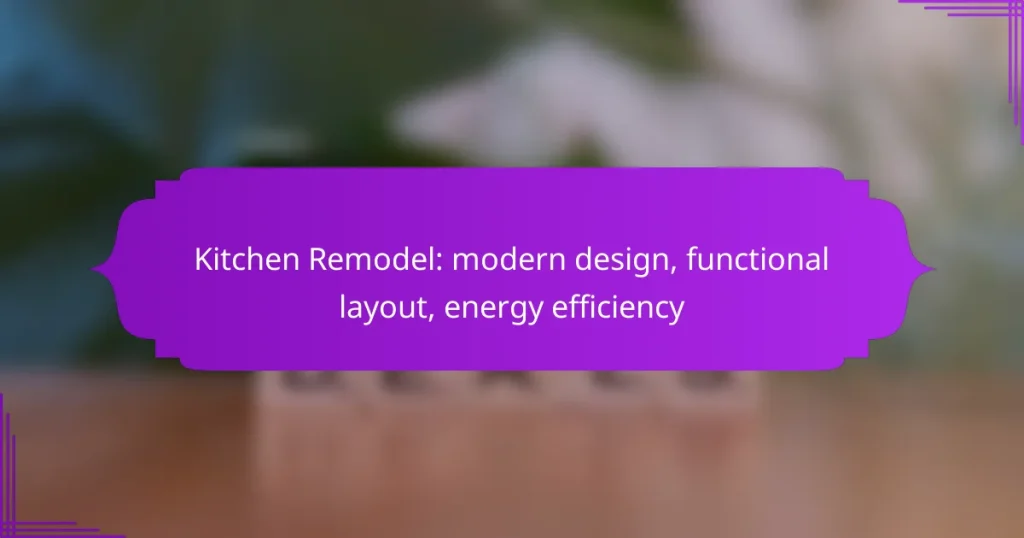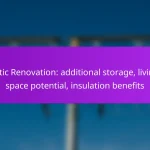A kitchen remodel can transform your space into a modern, efficient, and stylish hub of the home. By prioritizing contemporary design, functional layouts, and energy efficiency, you can create an inviting atmosphere that enhances both usability and sustainability. Incorporating elements like smart appliances, eco-friendly materials, and effective storage solutions will ensure your kitchen meets the demands of modern living while reducing your environmental footprint.

What are the best kitchen remodel solutions in Canada?
The best kitchen remodel solutions in Canada focus on modern design, functional layouts, and energy efficiency. Key elements include open concept layouts, smart appliances, eco-friendly materials, custom cabinetry, and energy-efficient lighting.
Open concept layouts
Open concept layouts enhance the flow and functionality of a kitchen by removing barriers between the kitchen, dining, and living areas. This design promotes social interaction and makes the space feel larger, which is particularly appealing in urban Canadian homes.
When considering an open concept layout, think about how the kitchen will integrate with adjacent spaces. Ensure that the layout allows for easy movement and access to appliances while maintaining a cohesive design aesthetic throughout the home.
Smart appliances
Smart appliances are increasingly popular in kitchen remodels, offering convenience and energy efficiency. These devices can be controlled remotely via smartphones, allowing for features like preheating ovens or monitoring refrigerator contents.
When selecting smart appliances, look for energy-efficient models that meet Canadian standards, such as ENERGY STAR certification. This not only reduces energy consumption but can also lead to savings on utility bills over time.
Eco-friendly materials
Using eco-friendly materials in your kitchen remodel can significantly reduce your environmental impact. Options include sustainably sourced wood, recycled countertops, and low-VOC paints, which contribute to healthier indoor air quality.
Consider local suppliers for materials to minimize transportation emissions and support the Canadian economy. Additionally, look for certifications that ensure the materials are environmentally friendly, such as FSC for wood products.
Custom cabinetry
Custom cabinetry allows for tailored storage solutions that maximize space and enhance functionality. This option can be particularly beneficial in kitchens with unique layouts or specific storage needs.
When designing custom cabinetry, focus on materials and finishes that align with your overall kitchen aesthetic. Incorporate features like pull-out shelves, deep drawers, and built-in organizers to improve usability and efficiency.
Energy-efficient lighting
Energy-efficient lighting is crucial for both functionality and ambiance in a kitchen remodel. LED fixtures are a popular choice, consuming significantly less energy than traditional bulbs while providing ample illumination.
Incorporate a mix of task, ambient, and accent lighting to create a well-lit and inviting space. Consider dimmer switches to adjust lighting levels based on the time of day or activity, enhancing energy savings and comfort.

How to choose a modern kitchen design?
Choosing a modern kitchen design involves balancing aesthetics with functionality and energy efficiency. Focus on clean lines, efficient layouts, and sustainable materials to create a space that is both stylish and practical.
Minimalist aesthetics
Minimalist aesthetics emphasize simplicity and uncluttered spaces, which are key in modern kitchen design. Opt for sleek cabinetry, integrated appliances, and open shelving to create an airy feel.
Consider using fewer decorative elements and choosing high-quality materials that stand out on their own. This approach not only enhances visual appeal but also makes cleaning and maintenance easier.
Color palette selection
Selecting a cohesive color palette is crucial for a modern kitchen. Neutral tones like whites, grays, and beiges can create a timeless backdrop, while bold accents in colors like navy or emerald can add personality.
When choosing colors, consider the overall flow with adjacent rooms and the amount of natural light your kitchen receives. A well-thought-out palette can make the space feel larger and more inviting.
Incorporating natural light
Natural light is essential in modern kitchen design, as it enhances the ambiance and reduces reliance on artificial lighting. Large windows, skylights, or glass doors can significantly brighten the space.
When planning your layout, position work areas near windows to take advantage of daylight. Use reflective surfaces like glossy tiles or light-colored countertops to amplify the effect of natural light throughout the kitchen.

What are the key elements of a functional kitchen layout?
A functional kitchen layout focuses on efficiency and usability, incorporating design elements that enhance workflow and accessibility. Key components include the work triangle, effective storage solutions, and smooth flow between areas.
Work triangle optimization
The work triangle is a design principle that connects the three main areas of the kitchen: the stove, sink, and refrigerator. Ideally, these points should form a triangle with each side measuring between 4 to 9 feet, ensuring ease of movement while cooking.
When optimizing the work triangle, avoid placing obstacles in the path between these areas. Consider the layout’s shape; L-shaped or U-shaped kitchens often facilitate better flow compared to galley kitchens, which can feel cramped.
Storage solutions
Effective storage solutions are essential for maintaining a clutter-free kitchen. Incorporate a mix of cabinets, drawers, and open shelving to maximize space and accessibility. Use pull-out shelves and lazy Susans in corners to make the most of hard-to-reach areas.
Consider vertical storage options, such as wall-mounted racks or hanging pot organizers, to free up counter space. Aim for at least 15 to 20 linear feet of cabinetry to accommodate essential kitchen items without overcrowding.
Flow and accessibility
Flow and accessibility in a kitchen layout ensure that movement between work areas is smooth and intuitive. Maintain clear pathways of at least 36 inches wide to allow multiple users to navigate comfortably.
Incorporate features like wide doorways and adjustable shelving to enhance accessibility for all users, including those with mobility challenges. Ensure that frequently used items are within easy reach to improve efficiency during meal preparation.

What energy-efficient features should be included?
Incorporating energy-efficient features in your kitchen remodel can significantly reduce energy consumption and lower utility bills. Key elements include Energy Star appliances, LED lighting, and proper insulation and ventilation.
Energy Star appliances
Energy Star appliances are designed to use less energy than standard models, helping you save on electricity costs. When selecting appliances, look for the Energy Star label, which indicates compliance with energy efficiency guidelines set by the U.S. Environmental Protection Agency.
Consider investing in energy-efficient refrigerators, dishwashers, and ovens. For example, an Energy Star-rated refrigerator can use up to 15% less energy than non-rated models, translating to savings over time.
LED lighting options
LED lighting is a highly efficient option for kitchen illumination, consuming up to 75% less energy than traditional incandescent bulbs. They also have a longer lifespan, reducing the frequency of replacements.
When remodeling, consider using LED fixtures for task lighting, under-cabinet lighting, and ambient lighting. This not only enhances functionality but also contributes to a modern aesthetic while lowering energy costs.
Insulation and ventilation
Proper insulation and ventilation are crucial for maintaining energy efficiency in your kitchen. Insulation helps keep the space warm in winter and cool in summer, while effective ventilation prevents excess moisture and improves air quality.
Ensure that your kitchen is well-insulated, particularly around windows and doors. Installing energy-efficient exhaust fans can help remove heat and humidity, further enhancing comfort and efficiency.

What are the costs associated with a kitchen remodel in Canada?
The costs of a kitchen remodel in Canada can vary widely, typically ranging from CAD 15,000 to CAD 50,000 or more, depending on the scope and quality of materials used. Factors such as layout changes, appliance upgrades, and design choices significantly influence the overall budget.
Factors Influencing Kitchen Remodel Costs
Several key factors impact the costs of a kitchen remodel in Canada. These include the size of the kitchen, the complexity of the design, and the quality of materials selected. For instance, a small kitchen may require a lower investment compared to a larger space that involves extensive renovations.
Labor costs also play a significant role, as hiring skilled tradespeople can add to the overall expense. It’s advisable to obtain multiple quotes from contractors to ensure competitive pricing.
Average Cost Breakdown
On average, a kitchen remodel can be broken down into several categories: cabinetry, countertops, appliances, flooring, and labor. Cabinetry and countertops often account for the largest portion of the budget, typically around 30-40% of the total costs.
Appliances can vary significantly in price, with mid-range options costing around CAD 2,000 to CAD 5,000. Flooring choices, whether tile, hardwood, or laminate, can also influence the budget, generally ranging from CAD 1,500 to CAD 5,000.
Tips for Budgeting Your Kitchen Remodel
To effectively budget for your kitchen remodel, start by determining your priorities. Decide which elements are essential and which are optional, allowing for flexibility in your spending. Consider setting aside an additional 10-20% of your budget for unexpected expenses that may arise during the renovation process.
Research and compare prices for materials and labor to find the best deals. Don’t hesitate to negotiate with contractors and suppliers to achieve a more favorable price. Lastly, consider DIY options for smaller tasks to save on labor costs while still achieving a professional look.

